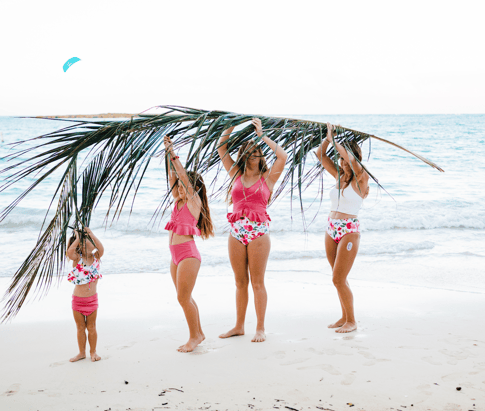Date
March 24 2024
Written By
Lizzie Shipton
When you choose a swimsuit, you probably don't give much thought to the swimwear fabric - beyond what color it is and if it has a cute pattern. But swimsuit fabric has a huge impact on the life span of your suit, and if you want your suit to last longer than one season, choosing the right fabric is important.
In this article, we'll break down the best fabric for swimwear and look at the pros and cons of each. By the end of this post, you should be able to decide which is the best swimsuit fabric for you, depending on your needs.
Let's dive in!
Does Swimwear Fabric Matter?
Your swimwear fabric takes a beating throughout its life! Exposure to chlorine, UV rays, salt, sand, sunscreen, and sweat degrade the material, especially if you're not rinsing with fresh water after every use. Add to that the fact that swimsuits sometimes get put away damp, and you might also be dealing with mold.
So when choosing swimsuit material, you want something that will retain its shape and color after repeated exposure to chlorine, salt, sand, and sun. Some swimwear fabrics are better than others when it comes to this. Some swimwear fabric is also treated with mold-resistant treatment.

Something else to consider when choosing swimsuit material is how much support you need from it. If you plan to wear the suit for surfing, beach volleyball, intense swimming, or other high-energy activities, you'll probably want sturdier fabric that keeps everything in place.
Finally, you may want to consider the environmental impact of your swimwear fabric. Some fabrics are more environmentally-friendly than others - for example, eco-friendly polyester fabric made from recycled plastic bottles, or nylon fabric made from old fishing nets or carpet.
What are the Common Types of Swim Fabric?
When it comes to swimwear fabric, there are three main types of material: spandex (also called elastane), polyester, and nylon. Let's take a closer look at each one to decide which is the best fabric for swimwear.
Spandex/Elastane
Spandex is the most commonly used swimwear fabric because it is stretchy, dries quickly, and resists pilling. The elastane fibers are usually blended with other natural or synthetic fibers like rayon, cotton blends or bamboo.
Spandex is one of the most durable swimsuit fabrics and can extend the life of a swimsuit by years as long as it is properly looked after. It is also has excellent UV resistant qualities, meaning it can withstand a lot of time on the beach or beside the pool.

Polyester
Polyester fabric is another synthetic fiber that is commonly used in swimwear. It's derived from petroleum and has been in use since the seventies. You do sometimes find clothes made entirely of polyester, but usually it's blended with other synthetic fibers or natural fabrics like cotton.
Polyester swimwear fabric is commonly blended with spandex to get the elastic qualities of spandex. Polyester is highly resistant to water damage and staining. It also has a high UPF rating, meaning it is UV resistant and great for beachwear.

Nylon
One of the other most common swimwear fabrics is nylon fabric. Nylon is actually a generic term referring to a family of synthetic fibers. It is very resilient and resistant to tearing and running, making it ideal material for tight, stretchy clothing like tights, leggings, and as swimwear fabric.
Nylon blends don't have quite the same elastic qualities as spandex or elastane fibers, but it has a good, very soft stretch. Nylon does not have the same moisture-wicking properties as polyester swimwear fabric or spandex, so it is not considered as good a material unless blended with one of these.

What Swimsuit Material is the Most Chlorine Resistant?
Compared to other swimwear fabrics, polyester swimwear fabric is more resistant to chlorine. This is because it is less porous, so less absorbent than other fabrics. However, swimsuit fabric can also be made more resistant to chlorine if the swimwear material is tightly woven.
There are also chemical treatments that can be used to treat swimsuit fabric to make it more chlorine resistant. Take note if you buy swimsuit fabric that has been treated with chlorine resistant chemicals - it needs special care. Make sure to hand wash with mild shampoo or detergent, and do not put it in the washing machine.
Which Swim Material Dries the Fastest?
Because it is less porous, polyester swimwear fabric dries faster than other synthetic fibers or swimsuit fabrics. However, the time-difference between the dry times of different fabrics is so small that most people won't notice a significant difference between, say, nylon and polyester.
Which Swim Material is the Most Eco-Friendly?
Of the three swimsuit fabric options we've covered, the least eco-friendly is polyester. It is non-biodegradable: it takes between 20-200 years to break down in a landfill. It's also derived from oil, which is obviously a major source of pollution.
When it comes to sustainability, there are new swimwear fabrics being developed specifically with sustainability in mind. Those are Econyl, Repreve, and Amni Soul Eco.
Econyl
Econyl is a type of regenerated nylon made from waste found in the ocean - typically fishing nets and other plastics. The creation of this fabric for swimwear goes beyond simply recycling the material: the nylon molecules are actually split and regenerated to create like-new nylon, meaning the resulting material is also recyclable and can be infinitely reused.
Repreve
Repreve is made from recycled plastic bottles. Bottles are collected, sorted, cleaned and flaked, and then flakes are melted, pressed and extruded to create Repreve fibers. the resulting fabric has great moisture-wicking properties, thermal regulation, and cushioning. It's used for everything from car interiors to swimsuits!
Amni Soul Eco
Amni Soul Eco takes a slightly different approach to sustainability: their fabric is created to break down quickly in landfills and produce very little waste. It is not recycled material, rather it is new material that has been purposefully created with sustainability in mind.
How to Choose the Best Swimsuit Fabric for You
By this point, it should be clear that there is no single best swimsuit fabric. The fabric that suits you best (see what we did there?) will depend on your particular needs and desires. If you plan to engage in a lot of high-intensity activity, synthetic fabrics like durable spandex and moisture-resistant stretch polyester might be best.

However, if you mostly plan to use your swimwear for sunbathing or just hanging by the pool, natural fabrics might be more comfortable. If sustainability is your main concern, opt for a recycled material or natural fibers and steer clear of synthetic fiber like nylon (unless it's regenerated.)
At the end of the day, the best fabric for swimwear is the one that best provides you with a comfortable and safe swim, and makes you feel like a million bucks.

